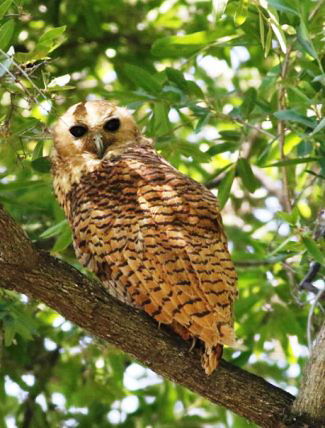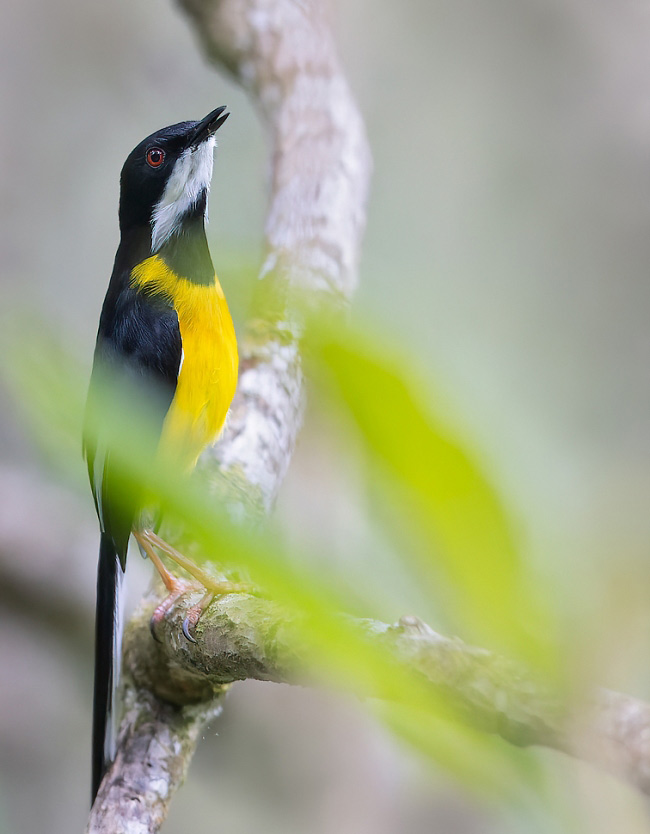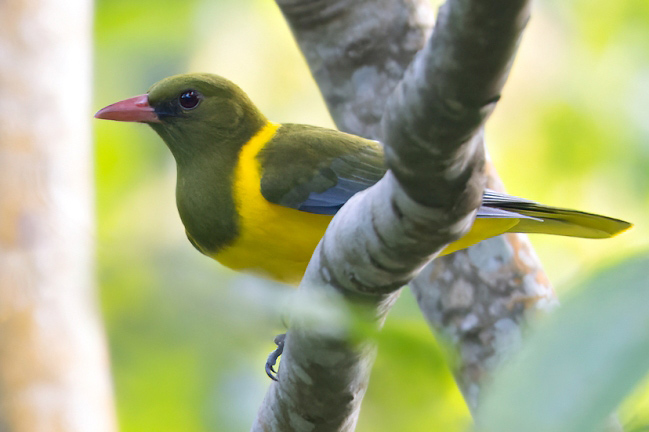

Pel's Fishing-owl by Chris Townend.
- Small country lots of wildlife
- Spectacular localized birds such as White-backed Night-heron, Lesser Jacana, African Skimmer, Pel’s Fishing-owl, Pennant-winged Nightjar, Boehm’s Bee-eater, Racket-tailed Roller, Blue Swallow and Babbling Starling
- Many Miombo woodland specialists in the best country to see them, including Stierling's Woodpecker, Pale-billed Hornbill, Miombo Rock-thrush, Souza's Shrike and Anchieta’s Sunbird
- As well as montane forest specialists such as Thyolo Alethe, White-winged and Yellow-throated Apalises, Green-headed Oriole and Red-faced Crimsonwing
- While more widespread spectacular African species include Goliath Heron, African Fish-eagle, Denham’s Bustard, Lilac-breasted Roller and hornbills
- And the many mammals include African Elephant, Hippopotamus, Sable, Roan, Nyala and Eland
- All in a small, thin country just 560 miles (900 km) long, although the burgeoning human population continues to have a devastating impact on the country outside and inside the parks and reserves.
- Malawi is a green, fertile country and most of the larger wildlife is confined to the parks and reserves. There are no Lions, even in these areas, so it is possible to walk around in many places, albeit with experienced rangers on the lookout for elephants.
- Many tour companies combine Malawi with South Luangwa National Park in neighbouring Zambia where it is possible to see additional mammals such as Lion, Leopard and Giraffe, and birds including Grey Crowned Crane and Southern Carmine Bee-eater (which nest here in large colonies). Some tour companies combine Malawi with Zimbabwe where it is possible to see African Pitta in late November-early December.

A fabulous White-winged Apalis by Dubi Shapiro.
Best Birds and other wildlife in Malawi
Birds
Endemics 1
Yellow-throated (Bar-throated) Apalis (likely to occur in adjacent Mozambique).
Near-endemics
Malawi and Tanzania 3 Churring Cisticola, Shelley’s Greenbul and Spot-throat.
Malawi, Tanzania and Zambia 10 Dark Batis, Fulleborn’s Boubou, Chapin’s Apalis, Black-lored Cisticola, Sharpe’s (Yellow-streaked) Greenbul, Rusty-flanked (Olive-flanked) Robin-chat, Sharpe’s Akalat, Whyte’s (Ludwig’s/Montane) Double-collared Sunbird, Montane (Buff-shouldered) Widowbird and Yellow-browed Seedeater.
Malawi, Tanzania and Mozambique 3 Stierling’s Woodpecker, White-winged Apalis (possibly still present in Kenya) and Olive-headed Greenbul.
Malawi, Tanzania, Mozambique and Zambia 6 Black-browed Mountain Greenbul, White-chested Alethe, Forest Double-collared Sunbird, Bertram’s Weaver, Olive-headed Weaver and Vincent’s (Cape) Bunting.
Malawi, Tanzania and Kenya 1 Kenrick’s Starling.
Malawi and Mozambique 2 Olive-flanked Robin-chat and Thyolo (Cholo) Alethe.
Malawi, Mozambique and Zambia 1 Malawi (Cape) Batis.
Malawi, Mozambique and Zimbabwe 1 Stripe-cheeked Greenbul.
Malawi, Zambia and DRC 1 Whyte’s (Shelley’s) Francolin.
Other specialities
Lilian’s Lovebird, Brown-headed Parrot, Pel’s Fishing-owl, Boehm’s Bee-eater, Racket-tailed Roller, Whyte's and Brown-breasted Barbets, Stierling's
Woodpecker, Blue Swallow,
Souza's Shrike, Boehm's and Livingstone's Flycatchers, Boulder Chat, Miombo Rock-thrush, East Coast Akalat, Green-headed Oriole, (White-winged) Babbling
Starling, Malachite, Red-tufted and Shelley's Sunbirds, Chestnut-backed Sparrow-weaver and Red-faced Crimsonwing. Also a chance of Buff-spotted and
Red-chested Flufftails, Wattled Crane,
Locust Finch and Lesser Seedcracker.
Others
Helmeted Guineafowl, Black and Goliath Herons, White-backed Night Heron, Rufous-bellied Heron, Hamerkop, African Darter, Palm-nut Vulture, African Fish and
Martial Eagles, Bateleur, Amur Falcon (Nov-Mar), Dickinson's Kestrel, Denham's Bustard, Black Crake, Blacksmith and Long-toed Plovers, African and Lesser
Jacanas, African Skimmer, Brown-necked Parrot, Livingstone’s, Purple-crested and Schalow’s Turacos, cuckoos, Spotted and Verreaux’s Eagle-owls, African
Wood Owl, Pennant-winged Nightjar, Red-faced Mousebird, Bar-tailed and Narina’s Trogons, kingfishers including Half-collared and Giant, bee-eaters
including Southern Carmine, rollers including Lilac-breasted, Green Woodhoopoe, hornbills including Pale-billed, Southern Ground-hornbill, barbets,
tinkerbirds, honeyguides, woodpeckers, African Broadbill, Retz’s and White Helmetshrikes, Black-fronted, Grey-headed and Sulphur-breasted Bushshrikes,
Brubru, African Paradise-flycatcher, White-headed Saw-wing, greenbuls, eremomelas, crombecs, Yellow-throated Woodland-warbler, Southern and Yellow-bellied
Hyliotas, flycatchers including Collared (Nov-Mar), White-starred Robin, robin-chats, Arnot's Chat, Collared Palm-thrush, Orange Ground-thrush, African
Spotted Creeper, starlings, Red-billed Oxpecker, sunbirds, buntings, canaries, weavers including Southern Brown-throated, widowbirds, Green Twinspot, and
Eastern Paradise-whydah. Also a chance of African Pygmy Goose, Saddle-billed Stork, Verreaux’s Eagle, African Finfoot and Greater Painted-snipe.
Mammals
African Elephant, Hippopotamus, African Buffalo, Eland, Impala, Greater Kudu, Nyala, Roan, Sable, Suni, Common
Waterbuck, Burchell’s Zebra, Yellow Baboon, Mitis, Samango and Vervet Monkeys, Lesser Bushbaby, Large Spotted Genet and Four-toed Elephant Shrew.
Also a chance of Leopard, Spotted Hyaena and South African Porcupine.
Reptiles
Nile Crocodile.
Fish
There are about a thousand species of fish in Lake Malawi - a world record for one lake – and most of them are brightly
coloured cichlids.
Invertebrates
The huge, billowing plumes of what look like smoke above the surface of Lake Malawi (mostly between
December and February during the rainy season) are actually composed of billions of midges or ‘Lake Flies’ as they are more popularly known.

Green-headed Oriole by Dubi Shapiro.
Best Sites for Birds and other wildlife in Malawi
- Lilongwe Nature Sanctuary A chance of African Finfoot, Half-collared Kingfisher and African Broadbill.
- Dzalanyama Miombo specialities including Pale-billed Hornbill, Whyte's Barbet, Stierling’s Woodpecker, Souza’s Shrike, African Spotted Creeper, Boulder Chat, Miombo Rock-thrush and Anchieta’s Sunbird. Also a chance of Red-chested Flufftail and Lesser Seedcracker.
- Luwawa Forest, Viphya Plateau Chapin's Apalis, Olive-flanked Robin-chat and Bertram’s Weaver. Also a chance of Red-chested Flufftail.
- Mkuwazi Forest, Chintheche Narina’s Trogon and East Coast Akalat.
- Nyika Plateau Red-winged Francolin (endemic crawshayi), Verreaux’s Eagle, Denham’s Bustard, Montane (Ruwenzori/Usambara) Nightjar (guttifer), Bar-tailed Trogon (Chowo Forest and Zovo-Chipolo), Moustached Green Tinkerbird, Malawi Batis, Fulleborn's Boubou, Sharpe’s Greenbul, Blue Swallow (Chelinda Camp Dam), Black-lored, Churring and Wailing Cisticolas, Brown-headed and Chapin’s Apalises, White-chested Alethe, Olive-flanked Robin-chat, Sharpe’s Akalat, Malachite, Red-tufted and Whyte's Double-collared Sunbirds, Montane Widowbird, Yellow-browed Seedeater, Bushpig, Eland and Roan. Also a chance of Red-chested Flufftail.
- Vwaza Marsh NP Babbling Starling, as well as Arnot's Chat, Miombo Blue-eared Starling and Chestnut-backed Sparrow-weaver.
- Nkhotakota GR Miombo specialities including Pale-billed Hornbill and Arnot’s Chat, as well as Boehm’s and Swallow-tailed Bee-eaters, and Southern Ground-hornbill.
- Senga Bay Black and Rufous-bellied Herons, Lesser Jacana, Boehm’s Bee-eater and ‘Lake Flies’. Also a chance of African Pygmy Goose and Greater Painted-snipe.
- Dedza A chance of Locust Finch in dambos (marshes).
- Chongoni FR Souza’s Shrike, African Spotted Creeper, Collared Flycatcher and Miombo Rock-thrush.
- Liwonde NP Black, Rufous-bellied and White-backed Night Herons, African Fish and Martial Eagles, Dickinson's Kestrel, Long-toed Plover, African Skimmer, Lilian’s Lovebird, Brown-necked Parrot, Pel’s Fishing-owl, Boehm’s Bee-eater, Racket-tailed Roller, Southern Ground-hornbill, Brown-breasted Barbet, Meves's Long-tailed Starling, Livingstone’s Flycatcher, Arnot’s Chat, Collared Palm-thrush, Southern Brown-throated Weaver, African Elephant, Black Rhino (introduced, in an enclosure), Hippopotamus (possibly the highest density in the world), Greater Kudu, Sable, Impala, Large Spotted Genet, Four-toed Elephant Shrew and Nile Crocodile.
- Zomba A chance of White-winged (Botanical Garden) and Yellow-throated (Kuchawe Inn area) Apalises, Olive-headed Greenbul and Thyolo Alethe (Kuchawe Inn area and Trout Farm).
- Thyolo Mountain Satemwa Tea Estate White-winged Apalis, Thyolo Alethe, Black-fronted Bushshrike, Orange Ground-thrush, Green-headed Oriole, Yellow-throated Woodland-warbler and Harrison’s Soft-furred Fruit Bat (Huntingdon House, Satemwa Tea Estate). Also a chance of Buff-spotted Flufftail.
- Lengwe NP Narina’s Trogon, Boehm’s Bee-eater, Livingstone’s Flycatcher, Nyala and Impala.
Best Times for Birds and other wildlife in Malawi
The beginning of the rainy season, which usually lasts from December to February, is the best time for birds because they are starting to nest then and are at their most active and attractive. Late November-early December is usually the peak time but October is better if combining Malawi with South Luangwa NP in Zambia since this normally coincides with the Southern Carmine Bee-eater nesting season.
Recommended Bird Books etc. for Malawi
Birds of Malawi: A supplement to Newman’s Birds of Southern Africa by K Newman et al. Southern, 1992.
SASOL Birds of Southern Africa by I Sinclair et al. C Struik, 2020 (Fifth Edition).
Birds of Africa south of the Sahara by I Sinclair and P Ryan. C Struik, 2011 (Second Edition).
Newman's Birds by Colour by K Newman. C Struik, 2011 (Third Edition).
Newman's Birds of Southern Africa by K and V Newman. C Struik, 2010 (Tenth Edition).
Roberts Bird Guide edited by H Chittenden. Africa Geographic, 2007.
Southern African Birdfinder by C Cohen and C Spottiswoode. New Holland Publishers, 2005.
Stuarts' Field Guide to Mammals of Southern Africa by C and M Stuart. Random House Struik, 2015 (Revised Edition).
The Kingdon Field Guide to African Mammals by J Kingdon. Bloomsbury, 2015 (Second Revised Edition).
The Kingdon Pocket Guide to African Mammals by J Kingdon. Bloomsbury, 2016 (Second Edition).
Apps etc.
eGuide to Mammals of Southern Africa
Kingdon eGuide to African Mammals.
Audubon African Wildlife.
SASOL eBirds of Southern Africa.
Newman's Birds of Southern Africa.
Roberts Multimedia Birds of Southern Africa.
Where to watch birds in Africa by N Wheatley. Helm, 1995.
Don’t know which country/countries to visit in Africa? Then it may be worth considering taking a look at this book, written by this website’s author. It is many years old of course but it still provides a starting point, an overview and a guiding light to the best birds and the best places to look for them on the continent, and could save hours of searching for similar information on the internet. However, it is important to check more up-to-date sources for sites which have been opened up, sites and species which have been discovered, lodges that have been built etc. since the book was published.
Birding and Wildlife Trip Reports for Malawi
Many trip reports, some for Malawi, are posted on the websites listed here. On some of these websites some reports are independent and some are posted by tour companies who organize tours to Malawi. These tour companies and others also post their own reports on their websites, which are listed under 'Some Organized Tours to Malawi' below.
- The best website for trip reports is CloudBirders
- but these are also worth a look
- Birdtours
- Fatbirder
- Jon Hornbuckle
- Mammal Watching
Local bird and wildlife guides in Malawi
The costs of organized tours partly reflect the quality of the tour leaders. Some leaders are certainly better than others and many companies claim their leaders are the best but even the best rely at least to some extent on the exceptional skills of the local guides they employ. If you are travelling independently, employing such local guides will greatly increase your chances of seeing the wildlife you wish to see.
Accommodation for birders in Malawi
Some Organized Tours for birds and other wildlife to Malawi
There are many tour companies who organize tours to see mammals, birds, other wildlife and other natural wonders. The cost of these tours vary considerably according to such variables as the airlines used, the number of days the tours last, the number of sites visited, the number of people in the group (an important consideration if you wish to see such wildlife as rainforest mammals and birds), the number of tour leaders, the standard of accommodation and transport, and the percentage profit the company hopes to make. Generally, where the number of days tours last and the number of sites visited are similar, the cheapest tours are those that use the cheapest airlines, accommodation and local transport, that have the largest groups with the least number of leaders, and that make the least amount of profit. The most expensive tours tend to be those which are exceptionally long, use the most expensive accommodation (ridiculously lavish in some cases, even for single nights) and which make the most profit. Some tour costs partly reflect the quality of the tour leaders. Some leaders are certainly better than others and many companies claim their leaders are the best but even the best rely at least to some extent on the exceptional skills of the local guides they employ.
While tour companies organize tours with set itineraries many also organize custom tours for individuals and private groups who instead of taking a tour with a set itinerary want to follow their own itinerary to suit their own personal tastes, whether it be mammals, birds, other wildlife, other natural wonders or even man-made attractions, or a mixture of them all. Many organized tours with set itineraries are also fast-paced and target as many species as possible, whether they are mammals, birds or other wildlife or everything, which usually leaves little time to enjoy the best sites and individual species, but on a custom tour those taking part can specify the pace and the sites and species they wish to concentrate on. Custom tours also suit people who like to travel with people they already know, rather than with a group of strangers, and they are popular with people with partners with different interests. Individuals, partners and small groups will almost certainly have to pay more for a custom tour than an organized tour with a set itinerary but a large group of friends may be able to travel for less than the price quoted for a set tour.
Tour companies who run organized tours to Malawi include the following. Many of these also offer custom tours.
- Birding Africa
- Birdquest (with Zimbabwe)
- Naturetrek
- Rockjumper
- Wildlife Worldwide
